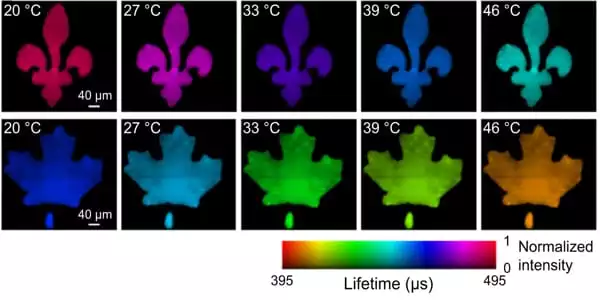Temperature can now be measured in 2D, without contact, and in a matter of seconds. Recent advances in optical thermometry have highlighted the photoluminescence lifetime imaging of upconverting nanoparticles. Despite significant advances in photoluminescent temperature indicators, existing optical instruments lack the ability to perform real-time wide-field photoluminescence lifetime imaging, limiting dynamic temperature mapping.
Professors Jinyang Liang and Fiorenzo Vetrone’s teams at the Institut national de la recherche scientifique (INRS) have developed a new imaging technique that can measure temperature in 2D, without contact, and in a matter of seconds. Their findings were published in the journal Nature Communications. This precise real-time temperature detection may one day improve photothermal therapy and aid in the early detection of skin cancers.
The luminescence of nanoparticles doped with rare earth ions is used in this technology, known as single-shot photoluminescence lifetime imaging thermometry (SPLIT). “They are referred to as nanothermometers because their luminescent properties change in response to environmental temperature.” “They’re also biocompatible,” says Professor Vetrone, a pioneer in this field of research.
SPLIT is faster and has higher resolution than existing thermometry techniques. This enables more accurate temperature sensing while also providing an advanced and cost-effective solution.
Professor Liang
Rather than imaging the luminescence point by point, which takes time, SPLIT employs a novel ultrahigh-speed camera to track how quickly the luminescence decays of these nanoparticles in each spatial point. “Unlike a standard camera, which captures one image with each click, our camera works by capturing all of the images of a dynamic event into a single snapshot.” Then we reconstruct them, one by one,” says Xianglei Liu, a Ph.D. student at INRS and the lead author of this article.
The temperature can then be determined by observing how quickly the emitted light fades out. Because it is in real-time, SPLIT can observe the phenomenon as it occurs. It enables luminescence thermometry using the lifetime of a nanoparticle with a moving sample for the first time. “SPLIT is faster and has a higher resolution than existing thermometry techniques. This enables more accurate temperature sensing while also providing an advanced and cost-effective solution” Professor Liang, an expert in ultrafast imaging, adds.

Health applications
Professors Liang and Vetrone believe that SPLIT technology could improve the detection and treatment of skin cancers. At the moment, the ability to detect melanomas, specifically micro-melanoma, is still limited. Existing diagnostic approaches are limited in their invasiveness, resolution, and accuracy, resulting in a large number of unnecessary biopsies.
Optical thermometry could thus be used to detect cancer cells, whose rapid metabolism results in a higher temperature than normal tissue, making them more visible with SPLIT. Clinics can use a thermal camera to detect melanoma, but the resolution is poor. “SPLIT represents an important step forward in technological development. With its high resolution, the technology could be used to precisely locate the cancerous mole” says Professor Liang.
This technology could also be used to monitor the light dose during certain types of treatment, in addition to detection. Photothermal therapy, for example, uses heat generated by near-infrared light to attack cancer cells. “We want to eradicate cancer but not the surrounding tissue, so if the temperature rises too high, the treatment may be reduced or discontinued for a period of time. If it is too low, we can increase the light to achieve the desired dose” Vetrone explains.
Temperature is a critical parameter in many physical, chemical, and biological processes. Temperature sensing at microscopic scales that is accurate and real-time (i.e., the actual time the event occurs) is critical for both industrial applications and scientific research, such as the examination of internal strains in turbine blades, control of the synthesis of ionic liquids, and cancer theranostics. Photoluminescence lifetime imaging (PLI) has emerged as a promising approach to temperature sensing over the last decade. The Canadian Cancer Society estimated that 8,000 Canadians would be diagnosed with this type of cancer alone by 2020.





